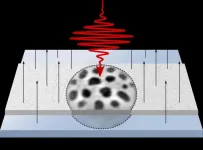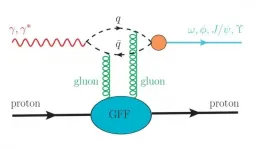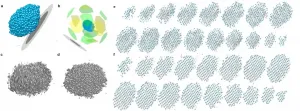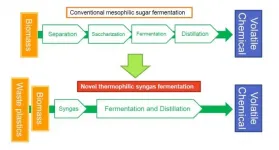(Press-News.org) May 1, 2021 - Rheumatologists in Hong Kong joined hands to develop a set of consensus statements on COVID-19 vaccination for local adult patients with autoimmune rheumatic diseases. These timely statements would serve to be a guide for rheumatologists, other specialists, family physicians, specialty nurses, and the public regarding COVID-19 vaccination for patients with rheumatic diseases.
Vaccination against SAR-CoV-2 is a new campaign and a high immunization rate is believed to be the key to end the pandemic. Currently, there are two COVID-19 vaccines available in Hong Kong--the inactivated virus vaccine CoronaVac® (Sinovac) and the mRNA-based vaccine Comirnaty® (BioNTech/Fosun). However, due to the paucity of experience in patients with autoimmune rheumatic diseases, there are concerns from patients regarding the efficacy and safety of the new COVID-19 vaccines. This underscores the importance of input from rheumatologists in providing appropriate advice to patients with autoimmune rheumatic diseases and other health-care providers on the COVID-19 vaccines.
The Hong Kong Society of Rheumatology (HKSR) took the lead to develop a set of consensus statements for the use of COVID-19 vaccines in local adult patients with autoimmune rheumatic diseases. Twenty-seven core members of the HKSR, including council members and rheumatologist-in-charge of most hospitals, met by teleconference on March 19, 2021, to discuss clinical questions related to COVID-19 vaccination in adult patients with autoimmune rheumatic diseases. Important clinical questions were summarized and statements were drafted. A systemic literature search was subsequently conducted to identify and grade the relevant evidence and the strength of recommendations for each statement.
A total of eight statements were finalized. Full members of the HKSR were invited to show their agreement to the statements in an on-line survey. Consensus of all the eight statements was reached after two rounds of voting. The eight statements with their grade of evidence and strength of recommendations are:
Statement 1
"There is limited evidence to suggest that adult patients with autoimmune rheumatic diseases have increased risk of COVID-19 infection."
Grade of Evidence: C
Strength of recommendation: B
Statement 2
"Adults patients with autoimmune rheumatic diseases may develop more severe COVID-19 infection than the general population."
Grade of Evidence: C
Strength of recommendation: A
Statement 3
"Vaccination against COVID-19 is recommended for patients with autoimmune rheumatic diseases that are under reasonable control. Local guidelines and precautions of the respective vaccines should be followed."
Grade of Evidence: D
Strength of recommendation: A
Statement 4
"The immunogenicity of various COVID-19 vaccines in patients with autoimmune rheumatic diseases is currently uncertain. In view of the concomitant immunomodulating/ immunosuppressive medications, the efficacy of these vaccines might be compromised."
Grade of Evidence: C
Strength of recommendation: B
Statement 5
"There is no evidence of increased risk of disease flares or adverse events in autoimmune rheumatic diseases, in the absence of other comorbidities, after COVID-19 vaccination."
Grade of Evidence: C
Strength of recommendation: A
Statement 6
"There is currently no evidence that adjusting the dosage schedule of immunosuppressive drugs would enhance the efficacy of the COVID-19 vaccines."
Grade of Evidence: D
Strength of recommendation: B
Statement 7
"In patients using heavy immunosuppressive or multiple treatment modalities, particularly those with long half-lives, a discussion with attending rheumatologists is suggested for the need to adjust dosage schedule on an individual basis."
Grade of Evidence: D
Strength of recommendation: B.
Statement 8
"In patients receiving rituximab, COVID-19 vaccine is best administered shortly before the next due dose. When the underlying autoimmune rheumatic diseases are stable, postponement of rituximab infusion for 4 weeks might be considered."
Grade of Evidence: D
Strength of recommendation: B
"This set of consensus recommendations was developed by more than 60% of the practicing rheumatologists in our locality. It took into consideration the limited existing evidence and local perspectives such as the availability of specific vaccines as well as the outbreak situation in Hong Kong. Our recommendations also emphasize patient-centered discussion and individualized decision," says Dr Chi Chiu Mok, the lead of the project, of Tuen Mun Hospital.
"Specific trials on various aspects of COVID-19 vaccines in patients with rheumatic diseases are expected to flourish in the coming months. The information in the current recommendations will likely need to be updated upon the emergence of new data." adds Dr Ronald Yip, the President of the HKSR.
The HKSR members who participated in the preparation meeting for the consensus statements or the subsequent Delphi exercise included (in alphabetical order): Drs. Chi Kit Au, Tak Hin Chan, Ka Ho Chan, Julia Chan, Eric Pak To Chan, Lucia Chau, Tommy Cheung, Sammas Chu, Ho Yin Chung, Natalia Ciang, Carmen Ho, Ling Yin Ho, Kitty Yan Kwok, Billy Lai, Virginia Lao, Chak Sing Lau, Clara Law, Ka Lai Lee, Gavin Lee, Patrick Man Leung Lee, Samson Lee, Moon Ho Leung, Edmund Li, Philip Hei Li, Kai Yiu Ma, Kam Hung Ng, Woon Leung Ng, Ray Ng, Hin Ting Pang, Lydia Tam, Lai Shan Tam, Ronald Tan, Sandy Tang, Chi Hung To, Man Choi Wan, Victor Tak Lung Wong, Raymond Wong, Priscilla Wong, Stella Wong, Sandy Woo, Winnie Yeung, Cheuk Wan Yim, Shirley Ying, Carrel Yu, and Catherine Yuen.
The paper The Hong Kong Society of Rheumatology Consensus Recommendations for COVID-19 Vaccination in Adult Patients with Autoimmune Rheumatic Diseases can be found in the Journal of Clinical Rheumatology and Immunology https://www.worldscientific.com/worldscinet/jcri.
INFORMATION:
Parks played an important role for people seeking respite from the toll of social isolation during the pandemic, and according to new research from Drexel University, they did so without increasing the spread of COVID-19. The study looked at how people used 22 parks in Philadelphia and New York during the height of the pandemic and it found no strong correlation between park use and the number of confirmed cases in surrounding neighborhoods.
Published in the Journal of Extreme Events, Drexel's study "Urban Park Usage During the COVID-19 Pandemic" surveyed park visitors over a three-month period from May to July 2020 at small and mid-size parks in New York and Philadelphia. And it compared park usage numbers ...
An essential preliminary to building and construction or resource extraction is studying the geological structure of the site. One of steps of this process is geophysical investigation. This provides a continuous overview of the geological horizons rather than just data on points: boreholes. The standard methods of geophysics help successfully solve this problem in comparatively simple conditions. Yet the classical direct current methods may lead to serious inaccuracy if we have to investigate geologically complex structures with thin layers of sandy and clayey soils.
Among the most popular methods ...
Leipzig/Jena/Ilmenau. Mobile apps like Flora Incognita that allow automated identification of wild plants cannot only identify plant species, but also uncover large scale ecological patterns. These patterns are surprisingly similar to the ones derived from long-term inventory data of the German flora, even though they have been acquired over much shorter time periods and are influenced by user behaviour. This opens up new perspectives for rapid detection of biodiversity changes. These are the key results of a study led by a team of researchers from Central Germany, which has recently been published in Ecography.
With the help of Artificial Intelligence, plant species ...
The gopher tortoise (Gopherus polyphemus) is declining because of habitat loss and fragmentation, human interaction including collisions with vehicles, predation by domestic animals, and disease. These long-lived reptiles are found throughout Florida and are affected by various diseases including upper respiratory tract disease. A number of pathogens such as Mycoplasma spp., Herpesvirus, and Ranavirus are known to cause upper respiratory tract disease in gopher tortoises. Chronic disease resulting from these pathogens can lead to reduced reproduction, abnormal growth and development, increased susceptibility to secondary ...
Lysophospholipids are phospholipids that have just one fatty acid chain, and in recent years, the role of lysophospholipids in physiology and pathophysiology has attracted attention. Lysophosphatidylethanolamine (LPE) is a type of lysophospholipid that are reportedly present in the brain that consist of many species with different fatty acid chain lengths and degrees of unsaturation. The latest studies in animal models have reported elevated levels of LPE in the brain after traumatic brain injury and cerebral ischemia. Fluctuations in LPE concentration have also been reported in the plasma of patients with major depression and Alzheimer's disease. Although these reports suggest the involvement of LPE in brain function, the role of LPE in the brain has remained unclear.
Therefore, ...
Smaller, faster, more energy-efficient: future requirements to computing and data storage are hard to fulfill and alternative concepts are continuously explored. Small magnetic textures, so-called skyrmions, may become an ingredient in novel memory and logic devices. In order to be considered for technological application, however, fast and energy-efficient control of these nanometer-sized skyrmions is required.
Magnetic skyrmions are particle-like magnetization patches that form as very small swirls in an otherwise uniformly magnetized material. In particular ferromagnetic thin films, skyrmions are stable at room temperature, with diameters down to the ten-nanometer range. It is known that skyrmions can be created and moved by short pulses of electric current. Only recently it was discovered ...
Researchers have recently extracted the proton mass radius from the experimental data.
A research group at the Institute of Modern Physics (IMP) of the Chinese Academy of Sciences (CAS) presented an analysis of the proton mass radius in Physical Review D on May 11. The proton mass radius is determined to be 0.67 ± 0.03 femtometers, which is obviously smaller than the charge radius of the proton.
In the Standard Model, the proton is a composite particle made of quarks and gluons and it has a non-zero size. The radius of the proton is a global and fundamental property of the proton. It is related to the color confinement radius -- a property governed by quantum chromodynamics (QCD).
The radius of the proton is approximately 100,000 times smaller ...
Atoms are the basic building blocks for all materials. To tailor functional properties, it is essential to accurately determine their atomic structures. KAIST researchers observed the 3D atomic structure of a nanoparticle at the atom level via neural network-assisted atomic electron tomography.
Using a platinum nanoparticle as a model system, a research team led by Professor Yongsoo Yang demonstrated that an atomicity-based deep learning approach can reliably identify the 3D surface atomic structure with a precision of 15 picometers (only about 1/3 of a hydrogen atom's radius). The atomic displacement, strain, and facet analysis revealed that the surface atomic structure and strain are ...
The study conducted by the University of Turku and the Finnish Institute for Health and Welfare together with an international research team is so far the largest population-level study in the world examining the connection between human gut microbiota and health and mortality in the following decades.
The composition of the research subjects' gut microbiota was analysed from stool samples collected in 2002. The researchers had access to follow-up data on the subjects' mortality until 2017, i.e., close to the present day.
"Many bacterial strains that are known ...
Acetone, a volatile solvent used for everything from removing nail polish and cleaning textiles to manufacturing plastics, could get a sustainability boost from a new strain of bacteria engineered by a research team based in Japan.
They published the details of the heat-loving, acetone-producing bacteria called Moorella thermoacetica on April 23 in AMB Express.
Acetone is typically produced through the widely used cumene method, which is cost-effective but not sustainable. The process, developed in 1942, involves converting two non-renewable resources into acetone and phenol, another chemical ...






